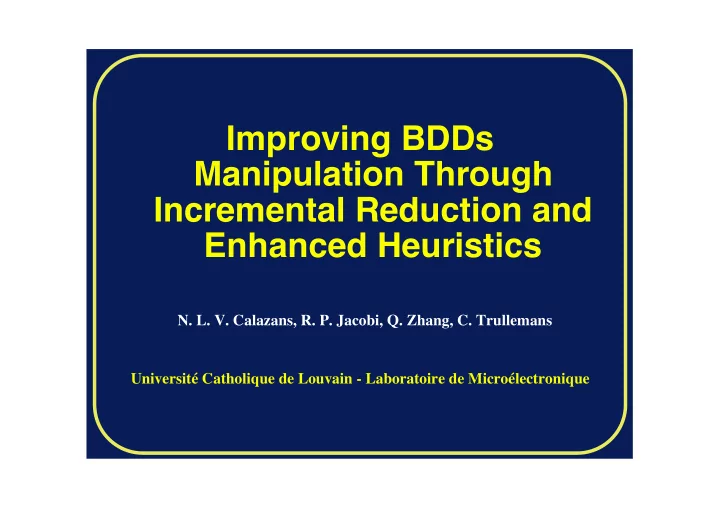

Improving BDDs Manipulation Through Incremental Reduction and Enhanced Heuristics N. L. V. Calazans, R. P. Jacobi, Q. Zhang, C. Trullemans Université Catholique de Louvain - Laboratoire de Microélectronique
Summary • Introduction • MBDs and Boolean Verification • Ordering of Input Variables • Incremental Manipulation • Benchmark Results • Conclusions and Future Work
Canonical BDDs Characteristics • Used to represent and manipulate Boolean functions (general); • Applied to design verification, symbolic simulation, logic synthesis, etc; • Subject to a problem: Establishing the variable ordering.
Our Approach: • Generalization of BDDs for logic synthesis applications; • New initial ordering heuristics; • Incremental techniques to change the ordering dynamically.
Summary √ Introduction • MBDs and Boolean Verification • Ordering of Input Variables • Incremental Manipulation • Benchmark Results • Conclusions and Future Work
Example x 0 x 0 g f X X 0 X 1 X 0 0 x 1 x 1 x 1 x 1 X X 1 1 0 X 1 X x 2 x 2 g on g off g dc f on f off f dc x 0 x 0 x 0 x 0 x 0 x 0 x 1 x 1 x 1 x 1 x 1 x 1 x 2 x 2 x 2 x 2 x 2 x 2 x 2 x 2 0 1 0 0 1 1 0 1 1 0 1 0
Corresponding MBD f g x 0 x 0 x 1 x 2 x 2 0 X 1
Boolean Verification Relies on the computation of: g on ⊂ f on + f dc * f on ⊂ g on + g dc If this results in a tautology, f ≡ g. • For BDDs, 2-4 calls to apply ; • For MBDs, 1-2 calls to apply ; • For CSFs, no calls to apply needed.
Summary √ Introduction √ MBDs and Boolean Verification • Ordering of Input Variables • Incremental Manipulation • Benchmark Results • Conclusions and Future Work
Initial Ordering for Input Variables 2 n • Exact solution to date: O(n 3 ); • Heuristics are unavoidable; • Fujita et al. proposed depth-first search with pivots.
Depth-first ordering example t 8 a b t 12 c o 0 t 9 d t 10 e t 13 t 14 t 11 f g • One possibility: <(c b a) (e d g f)>
Tentative Enhancements • Sort intermediate/output variables; • Sort pivoted lists using transitive fan-in; • Combination of both. "Results were still rather erratic and dependent on input description."
Weighted Nodes Heuristic t 1 a t 2 b c o 0 t 3 t 4 d 1/8 a t 1 1/8 b 1/4 t 2 1/2 1 c 1/2 o 0 t 4 1/4 d 1/2 1/4 a t 1 1 1/4 o 0 b 1/2 1/2 d
Summary √ Introduction √ MBDs and Boolean Verification √ Ordering of Input Variables • Incremental Manipulation • Benchmark Results • Conclusions and Future Work
Supportive Statements -"Exchanging two adjacent variables in the ordering underlying a BDD changes only the levels of the BDD involved in the operation." -"The reduced BDD corresponding to the new ordering differs from the original reduced BDD only in the exchanged levels."
Operations needed • Swap , in order to exchange two variables in the ordering; x y x y y y x x x x y A C B C A B C D A B C A C B D (b) (a) x x A B A B (c) • Local-Reduce , in order to put the BDD back into a canonical form.
Example of Application: Incremental reduction of the number of nodes in an MBD using heuristics • Successive applications of Swap + Local-Reduce on selected pairs of adjacent levels ; • Heuristics for ordering selection of pairs and stop conditions: • best-pair swap ( swap-all-red ); • greedy swap ( swap-run-down ). • Best results were obtained with sequential application of both heuristics.
Summary √ Introduction √ MBDs and Boolean Verification √ Ordering of Input Variables √ Incremental Manipulation • Benchmark Results • Conclusions and Future Work
In our benchmarks: • MBDs provided average gain of 35% over separated BDDs; • Initial MBDs are 10% smaller in average, if weighted nodes heuristics is used; Difference is the same after incremental reduction; • Incremental reduction provided additional average gain of 21%. - More than 40 examples of various sizes run. Most benchmarks taken from MCNC and ISCAS.
Summary √ Introduction √ MBDs and Boolean Verification √ Ordering of Input Variables √ Incremental Manipulation √ Benchmark Results • Conclusions and Future Work
Conclusions • MBDs - a compact and efficient way of representing Boolean functions; • Underlying structure of network is explicit in MBDs; • Sharing among functions is also explicit; • Single graph for the whole network, on-, off-, and dc- sets; • New heuristic + inc. reduction = smaller MBDs, thus faster execution; • Incremental techniques provide a way to surpass the intrinsic limitation of BDDs/MBDs (total ordering of input variables).
Future Work • Extraction of sum-of-products representation from MBDs; • Factorization and decomposition; • Boolean division and other optimization techniques; • Sequential circuits considerations.
Recommend
More recommend